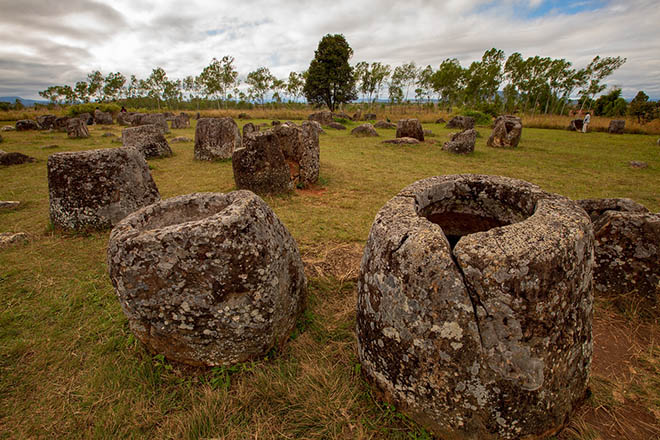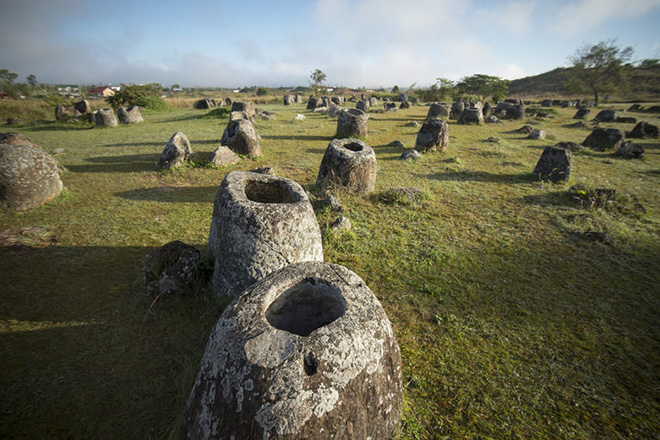In spite of being the only landlocked nation in Southeast Asia, the hidden beauty of Laos never fails to capture the heart of travelers in fields of myths and wonders. That’s why the Plain of Jars is always on the top search for historical and cultural destinations.
In case you never hear of such a mysterious place, we will give you a brief history of this significant landscape in Laos. Be prepared to dive in an unsought mystery of humankind!
Location And How To Get There
The Plain Of Jars is a massive area consisting of thousands of stone jars scattering around the Xiangkhoang Plateau. The plateau is at the northern end of the Annamese Cordillera, a major mountain range of Indochina.
Due to the magnificence of the landscape, the local authority has divided it into 90 jar sites. However, you are not allowed to wander around all 90 stops because of safety reasons. Tourists can be free to visit Site 1, Site 2, Site 3, Site 16, Site 23, Site 25, and Site 52.
The most popular choice is Site 1, which is the closest to Phonsavan town, super convenient for commuting. From Site 1, you can easily Site 2 by motorbike or tuk-tuk and then reach Site 3 via hiking. Site 52 is the largest area, beholding 392 jars, however, it is very remote and only accessible on foot.
Location of The Plain Of Jars (Site 1)
To join in a tour around the Plain Of Jars, you have to catch a flight to Vientiane or Luang Prabang, two transport hubs in Laos. From Vientiane airport, you can get on a plane operated by domestic airways such as Laos Airlines to arrive at Xiangkhoang airport, only 3 km from Phonsavan town, where Site 1 of the Plain of Jars is. Flights from Vientiane to Xiangkhoang takes merely 30 minutes, however, costs up to $100.
You can also take a daily bus from either of Vang Vieng, Luang Prabang, Vientiane to Phonsavan. However, it is an 8 to 11-hour transfer, so you can be extremely exhausted, let alone carsick. The most cost-saving way maybe hire a private van or book a trip with a liable tour operator so that you can take control of your schedule.
To get into the field, you also need to pay an entrance fee of about $1.5, which is more than affordable.

Mysteries Behind Plain Of Jars
Despite the best attempts of the archaeologists, the origin and purpose of the Plain of Jars still remain a mystery.
The jars have various height and diameter, ranging between 1m and 3m. All of them were hewn from rock, giving an impression of the iconic Stonehenge of the United Kingdom. Their cylindrical shape is usually wider at the bottom with bas-reliefs carved on the exterior. However, the decoration was only found on jars situated at Site 1.
The rock painting depicted some kinds of animals like frogs, monkeys, and tigers… On enormous jars were carved with images of human knee bending and arms reaching towards the sky. Those pictures are similar to Chinese paintings traced back to 500 BC–200 AD, so there is guessing that the Plain of Jars was formed at that time too. Still, nothing can be sure about the mysterious culture that painstakingly carved in the stone jars. And the somber and eerie vibe is still embracing the Plain of Jars.
The jars used to be thought to be containers of food and rainwater, but after the discovery of human bones and teeth around the area in the 1930s, this theory was disproved. Instead, archeologists start to think of the jars as a burial for dead people. Familiar funerary practices are followed by Thai and Cambodian. However, as a result of the bombardment during wars, evidence gathered was not enough to make a firm statement.
Surrounded by a long gone history that can never be confirmed, the Plain of Jars is truly a destination for unsought mystery seekers to boost the adrenaline level with legends and tales.

The Landscape In The Modern Time
During the 20th century, the Plain of Jars was severely damaged in the Secret War caused by the U.S against Vietnam. Nowadays, there are still plenty of unexploded bombs inside the field, making it difficult for scientists to examine the area and somewhat dangerous for travelers to explore the Plain of Jars. Still, if you closely follow the guided track, there will be no sudden explosion afield.
UNESCO in collaboration with several non-governmental organizations also works hand in hand with the government to clear the site. Their efforts since 2004 have made about 6 jar sites free of bomb hazards, totally safe for tourism.




Comments